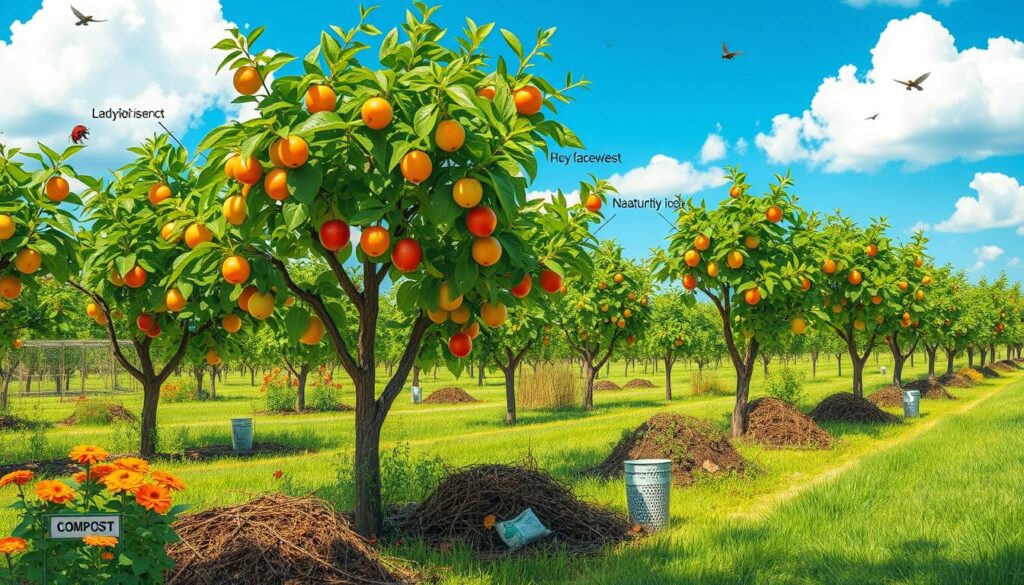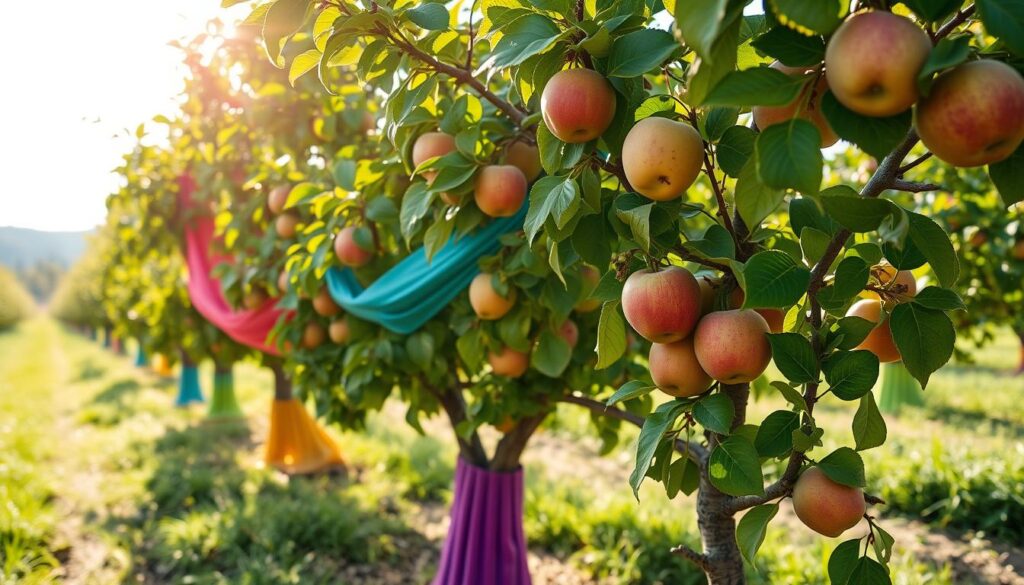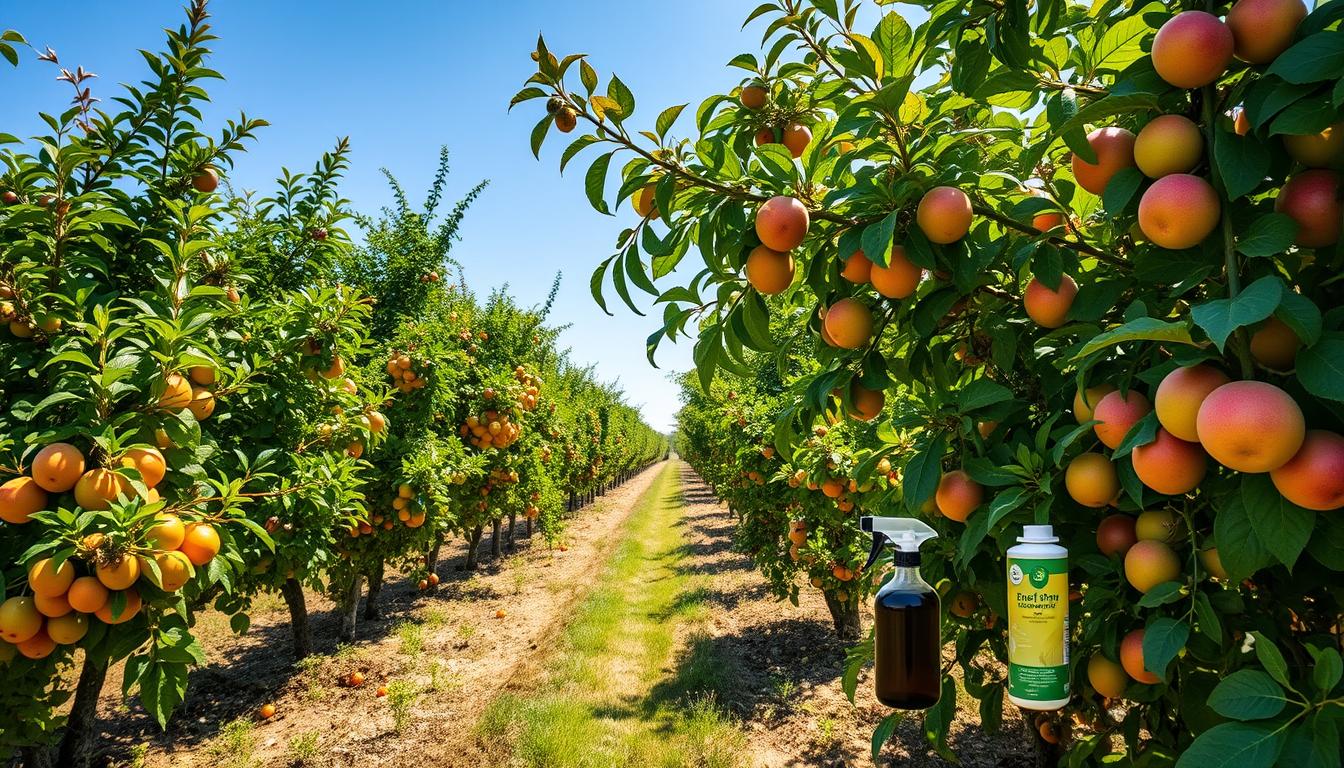As a gardener, I’ve always looked for ways to keep my fruit trees healthy. I’ve found that organic pest control is the best choice. This was especially true when earwigs attacked my apricot tree, cutting down its yield.
Over the past couple of years, I’ve tried different eco-friendly methods. These have been both effective and affordable.
In this article, I’ll share my favorite organic pest control methods for fruit trees. I’ll talk about how I used quilt batting, saran wrap, and Tanglefoot sticky substance to keep earwigs away. Using Tanglefoot for two apricot trees cost only about $5. This shows that you can protect your trees without spending a lot.
Next, I’ll explore natural ways to manage pests, common pests that target fruit trees, and how to keep your trees healthy. My goal is to give you practical tips for a thriving fruit garden that’s also good for the planet.
Key Takeaways
- Using organic methods can control pests while protecting the environment.
- Barriers made from quilt batting and Tanglefoot can stop infestations.
- There are affordable organic pest control options without losing quality.
- Regular care and watching for pests are crucial for success.
- Knowing the pests you face helps in choosing the right treatments.
The Best Organic Pest Control for Fruit Trees
Organic pest control is key for keeping fruit trees healthy. I’ve tried many methods and products to protect my trees. One effective tool is Tanglefoot, a sticky barrier that catches insects trying to climb the tree.
Wrapping trees with quilt batting or saran wrap also helps. It keeps pests away from the fruit. These simple steps are crucial for a good harvest. Michael Phillips, an expert in organic pest control, taught me a lot about keeping trees healthy.
Phillips says to avoid harmful chemicals. Instead, he uses a mix of liquid fish, neem oil, and molasses. This “Core Holistic Spray” is applied at different times to feed the trees and keep pests away.
Using organic pest control methods and attracting beneficial insects is essential. Resources like Garden Beginner offer great advice for gardeners. They help us improve our pest control efforts.
| Organic Pest Control Method | Description | Timing |
|---|---|---|
| Tanglefoot | Sticky barrier that traps crawling insects. | Apply throughout the growing season. |
| Quilt Batting/Saran Wrap | Material wrap to prevent pests from accessing fruit. | Before fruit development. |
| Core Holistic Spray | Mixture of liquid fish, neem oil, and other ingredients. | Early growth, before blossoms, after petal fall. |
Using these organic methods helps my garden grow strong and healthy. It keeps pests away and makes my trees fruitful.
Understanding the Importance of Organic Pest Control
Using organic pest control for fruit trees is key for their health and the ecosystem’s. Chemical pesticides can harm the environment and human health. They’ve been linked to serious diseases like cancer and Alzheimer’s. By choosing eco-friendly fruit tree pest control, I help my garden’s biodiversity. This protects good insects and keeps the ecosystem balanced.
The dormant season, from November to March, is a great time to tackle pests and diseases. I can deal with pests like mite eggs and scales during this time. A diluted spray of horticultural oil or organic treatments can help a lot. Each tree’s needs vary based on its environment, like in New York’s Lake Ontario area versus the Ontario Peninsula.
Knowing when to apply treatments is important. It matches the fruit trees’ growth stages. Understanding pests like wooly apple aphids helps me make better choices. Regular care, like pruning and clearing leaves, also helps prevent diseases. Resources like the guidelines on organic pest management help me do it right.
Going organic protects my fruit trees and the environment. It lets beneficial organisms live alongside my trees. This dedication to organic gardening makes my trees healthier and my gardening more sustainable.
Common Pests That Affect Fruit Trees
It’s key to know about common pests that harm fruit trees. This knowledge helps keep trees healthy and fruit abundant. Many insects can damage fruit trees, so spotting them early is vital.
- Aphids: These small insects feed on tree sap, weakening the tree and causing leaves to curl. Infestations can decrease fruit quality and yield.
- Codling Moths: Commonly affecting apple and pear trees, their larvae burrow into fruit, leading to eruptions and decay.
- Peach Twig Borers: They attack peach, nectarine, apricot, and plum trees, damaging the shoots and causing death if not controlled.
- Western Cherry Fruit Flies: These pests impact sweet and tart cherries, laying eggs that hatch into maggots, spoiling the fruit.
- Greater Peachtree Borers: Targeting peach and other stone fruit trees, these pests bore into the trunk and branches, harming the tree’s structure.
Spotting infestations early helps manage pests well. Using organic insect repellent for fruit trees can keep many pests away. Also, keeping the orchard clean by removing fallen fruit or debris helps prevent future problems.
Adding beneficial insects like ladybugs and lacewings to your orchard helps control pests naturally. They eat harmful pests, keeping the ecosystem balanced. Checking tree health, including brix levels, helps me see if trees are vulnerable to pests. This ensures my trees stay healthy and productive.
Effective Natural Pest Management Strategies
Keeping fruit trees healthy means using natural pest control. It’s important to attract beneficial insects. Ladybugs and lacewings eat pests, so we don’t need chemicals. We plant flowering dill, chives, mint, sage, yarrow, and borage to help them.
Cleaning the orchard is also key. Fallen fruit and debris attract pests. So, we clear them out often. This helps keep pest numbers down naturally.
Crop rotation is another good strategy. Rotating crops every three to five years helps fight pests. It keeps the soil and trees healthy for longer.

The Role of Beneficial Insects in Pest Control
In my experience with organic pest management, the role of beneficial insects for fruit trees is huge. These natural allies help keep the ecosystem balanced and control pests. By supporting insects like ladybugs and lacewings, gardeners help their fruit trees stay healthy.
To attract these beneficial insects, gardeners can design their landscapes with a variety of flowering plants. These plants offer nectar and pollen, supporting pollinators and pest predators. Adding native plants increases wildlife diversity, providing shelter and food for beneficial insects.
Lady beetles are known for fighting aphids and other pests. Studies show that keeping a steady number of these insects leads to better pest control. It’s important to watch both pest and beneficial insect numbers to see if pest control is working.
Also, I’ve learned to use insecticides carefully to protect beneficial insects. Products like ultrafine horticultural oil, insecticidal soaps, and neem products are safer. Using these methods helps beneficial insects for fruit trees thrive and aid in organic pest management.
Understanding the importance of beneficial insects helps me manage my fruit trees better. It also promotes a balanced ecosystem. For more information, check out this comprehensive resource.
Using Birds to Manage Fruit Tree Pests
Using birds to control pests is a great way to go green. Birds like Eastern bluebirds and tree swallows eat pests that harm fruit trees. By welcoming these birds, we can help keep pest numbers down naturally.
Putting up nesting boxes in orchards helps attract these helpful birds. For example, Avalon Orchards in Ontario has over 10,000 apple trees with birdhouses. This helps a lot with pest control. People often see birds like bluebirds and swallows show up quickly after putting up birdhouses.
But not all birds are good for fruit trees. Birds like American crows and European starlings can damage fruit. Crows make big holes in apples, and starlings eat a lot of fruit. To protect their crops, some places use nets.
Knowing about local bird populations makes bird-based pest control even better. Some areas face challenges, like birdhouses near busy roads. It’s important to remember that all birds are protected by law, except for pigeons, house sparrows, and European starlings. We need to be careful about managing birds that cause problems.
In summary, using birds for pest control is a smart choice. By creating homes for them and knowing which birds are helpful, we can protect our fruit trees. This also helps local wildlife.
Read more about our disclosurepolicy regarding affiliate links
Sticky Traps: A Simple Solution for Pest Reduction
Sticky traps are a simple and effective way to manage insects in fruit orchards. They are non-toxic, making them safe for the environment. Using them can greatly reduce pests while keeping beneficial insects safe.
There are many types of sticky traps, including Yellow Sticky Tape. It comes in widths like 2″, 6″, 10″, and 12″. Online sales are limited to 30 for 2″, 12 for 6″, 7 for 10″, and 6 for 12″. A recent review showed an 80% drop in pests overnight after using these traps.
These traps work well for small insects like thrips and flies. But, they might not catch larger pests like beetles and wasps as well.
“The 6″ width tends to fold in on itself. A 4″ width would be better,” mentioned a customer.
While helpful, some users found the tape less effective against Spotted Lantern Flies. Yellow sticky traps are coated on both sides. They can catch many insects, including aphids, thrips, and fungus gnats. They are easy to use because of their design.
| Trap Type | Width | Capture Effectiveness | User Feedback |
|---|---|---|---|
| Yellow Sticky Tape | 2″ | Strong, 80% reduction observed | Effective for small pests, less so for larger ones |
| Yellow Sticky Tape | 6″ | Good but folds | Suggests a 4″ width improvement |
| Yellow Sticky Tape | 10″ | Pest-specific effectiveness | Limited reviews |
| Yellow Sticky Tape | 12″ | Ideal for larger areas | Effective for many insects |
Tanglefoot® is another popular choice. It’s a tree resin used since 1885. It’s affordable, costing about $10 for a lot. It catches pests well without harming beneficial ones.
After two seasons, only one ladybug got stuck, showing it’s good at telling pests from beneficial insects. Sticky traps can catch flea beetles in 30 seconds. I’m also working on a 3D-printed version of sticky traps. I hope it will help others with pest problems.
Creating Barriers: Orchard Sox for Fruit Protection
Using orchard sox for fruit trees is a great way to keep pests away. These simple nylon sleeves protect young fruit from pests like apple maggots and codling moths. These pests have become more common in recent years.
Applying orchard sox is easy. I put them on when the fruit is about the size of a dime. This helps keep pests from laying eggs on the fruit. Using these pest barriers makes my harvest cleaner and healthier.

To get the best results, I also use sticky glue traps around the trees. These traps help me spot apple maggots. I change the traps every 30 to 60 days to keep track of pests.
Orchard sox work well for all kinds of fruit, even if you only have a few trees. They protect the fruit while it grows. Using these barriers regularly keeps my trees healthy and helps me get a big harvest.
Wrapping Your Trees: Materials and Techniques
Wrapping trees for pest control is a smart move. It keeps pests away effectively. I use quilt batting and saran wrap, which are easy to find and won’t break the bank. This combo creates a strong barrier against pests without the high cost of commercial tree tape.
To figure out how much material you need, measure your tree’s height and width. Add these numbers together, then multiply by 2. This formula ensures your tree is fully covered, especially when fighting pests.
When you wrap trees, make sure not to bend branches too much. This can harm the tree. For big trees, use netting on each major branch. It makes wrapping easier and saves material when branches are far apart.
Bagging fruits on the tree is also a great idea. It keeps diseases and insects away. This method is cheap and natural, like in China and Japan. It might take some time, but it protects many fruits without harmful chemicals.
Bagging apples, figs, and pears works well to keep pests off. My tests showed it’s very effective. For example, 94 out of 100 figs stayed safe in a study. It also prevents sunburn and keeps fruits fresh until they’re ready to pick.
Using Tanglefoot for Non-Toxic Insect Control
Tanglefoot is a big step forward in organic pest control for fruit trees. It’s a sticky substance that you put on the tree trunk. This barrier stops many crawling insects from getting to the trees.
I’ve seen it work well against pests like gypsy moths, ants, and cutworms. To use it, apply a smooth coat with a paintbrush. Make sure to wrap the trunk first for easy cleanup later.
The product is safe for organic gardens, thanks to being OMRI listed. It stays weather-proof all season, keeping your trees safe.
Ready-made codling moth traps can cost up to $13.01 for two. Protecting three apple trees could be $26.02. But, a quart of Tanglefoot costs $20.87 and works better. You can even make your own traps with items like tennis balls and green colored materials.
Tanglefoot is affordable. An 8-ounce container is $6.99, and Tree Tanglefoot Insect Barrier is $18.78 each. Buying in bulk can save you money. I plan ahead to get the best deal on pest control.
I also want to use Tanglefoot traps for flies in the orchard. It’s a great way to keep trees healthy and fruit-yielding. Using Tanglefoot helps my fruit trees thrive.
Promoting Tree Health to Prevent Infestation
Building a strong base for your fruit trees is key to stopping pests. By focusing on tree health, I make my trees strong against pests and diseases. Healthy trees are less likely to get damaged by pests.
Soil health is vital for fruit trees. Rich soil helps trees grow strong, which lowers the risk of pests. I ensure my soil has the right mix of organic matter, good drainage, and moisture for healthy roots.
Good watering habits are also crucial. I stick to a regular watering schedule, giving my trees enough water, especially when it’s dry. This makes the trees stronger and better at fighting pests.
Pruning is also important. I prune my trees often to remove dead or sick branches where pests can hide. This also lets more air and sunlight in, making the tree healthier.
Here are some tips for keeping trees healthy and pest-free:
- Test soil regularly to ensure proper nutrient levels.
- Add organic stuff like compost to make the soil better.
- Don’t overwater but keep the soil moist.
- Prune during the tree’s rest time to improve its shape.
- Use mulch around trees to keep the soil warm and moist.
By tackling these key areas, I help my fruit trees grow well. Healthy trees are less likely to get pests, so stopping pests is my main goal for good fruit production.
Conclusion
Exploring organic pest control for fruit trees has shown me the value of sustainable orchard management. Using non-toxic methods like crop rotation and introducing natural predators helps keep trees healthy. These practices also improve soil health and support biodiversity.
Healthy plants are less likely to attract pests. Sick plants, on the other hand, attract pests more easily. Homemade organic deterrents can also help manage pests without harming the environment. For instance, a baking soda and water mixture can fight fungal diseases.
Choosing organic pest control for fruit trees boosts crop health and helps the environment. Understanding these connections helps us garden more effectively and responsibly. For more on organic pest control, check out this useful article. Let’s use these methods for a greener and more fruitful garden.



Leave a Reply